Lynnfield và Clarkdale
config.plist cho hệ thống
Desktop Lynnfield và Clarkdale
Hỗ trợ macOS
OS X 10.6.3, Snow Leopard
Hệ điều hành được hỗ trợ lần cuối
macOS 12 Monterey
Note 1
Để biết thông tin về Ventura, hãy xem macOS 13 Ventura
Note 2
Apple không hỗ trợ iGPU Iron Lake trên máy tính để bàn
Note 3
Hầu hết các bo mạch Lynnfield và Clarkdale không hỗ trợ UEFI
Bắt đầu
Vì vậy, việc tạo config.plist có vẻ khó nhưng thực tế không phải vậy. Chỉ mất một chút thời gian nhưng hướng dẫn này sẽ cho bạn biết cách định cấu hình mọi thứ, bạn sẽ không bị bỏ rơi. Điều này cũng có nghĩa là nếu bạn gặp sự cố, hãy xem lại cài đặt cấu hình của mình để đảm bảo chúng chính xác. Những điều chính cần lưu ý với OpenCore:
All properties must be defined, there are no default OpenCore will fall back on so do not delete sections unless told explicitly so. If the guide doesn't mention the option, leave it at default.
The Sample.plist cannot be used As-Is, you must configure it to your system
DO NOT USE CONFIGURATORS, these rarely respect OpenCore's configuration and even some like Mackie's will add Clover properties and corrupt plists!
Now with all that, a quick reminder of the tools we need
Universal plist editor
For generating our SMBIOS data
Sample/config.plist(opens new window)
See previous section on how to obtain: config.plist Setup
WARNING
Read this guide more than once before setting up OpenCore and make sure you have it set up correctly. Do note that images will not always be the most up-to-date so please read the text below them, if nothing's mentioned then leave as default.
#ACPI
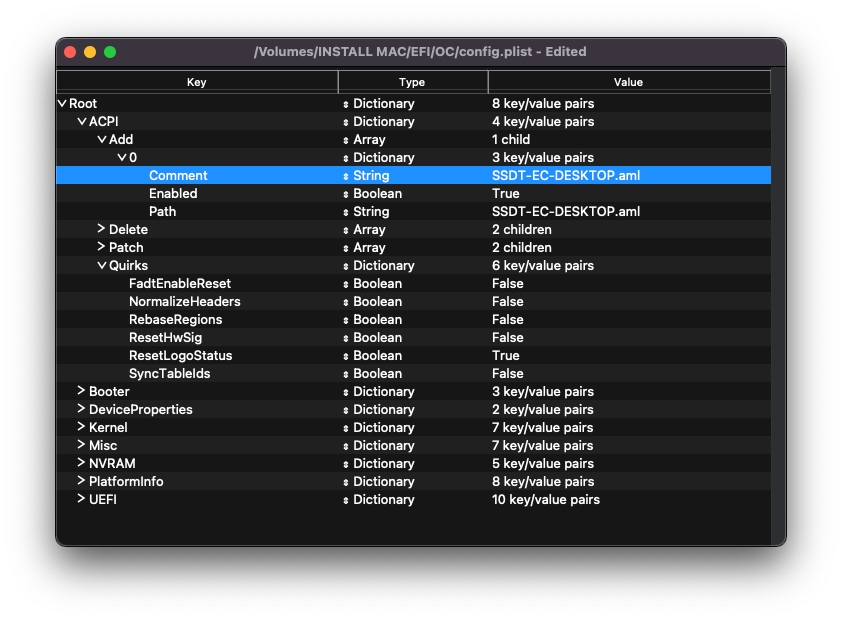
#Add
Info
This is where you'll add SSDTs for your system, these are very important to booting macOS and have many uses like USB maps (opens new window), disabling unsupported GPUs and such. And with our system, it's even required to boot. Guide on making them found here: Getting started with ACPI(opens new window)
For us we'll need a couple of SSDTs to bring back functionality that Clover provided:
Fixes the embedded controller, see Getting Started With ACPI Guide (opens new window)for more details.
Note that you should not add your generated DSDT.aml here, it is already in your firmware. So if present, remove the entry for it in your config.plist and under EFI/OC/ACPI.
For those wanting a deeper dive into dumping your DSDT, how to make these SSDTs, and compiling them, please see the Getting started with ACPI (opens new window)page. Compiled SSDTs have a .aml extension(Assembled) and will go into the EFI/OC/ACPI folder and must be specified in your config under ACPI -> Add as well.
#Delete
This blocks certain ACPI tables from loading, for us we can ignore this.
#Patch
This section allows us to dynamically modify parts of the ACPI (DSDT, SSDT, etc.) via OpenCore. For us, our patches are handled by our SSDTs. This is a much cleaner solution as this will allow us to boot Windows and other OSes with OpenCore
#Quirks
Settings relating to ACPI, leave everything here as default as we have no use for these quirks.
#Booter


This section is dedicated to quirks relating to boot.efi patching with OpenRuntime, the replacement for AptioMemoryFix.efi
#MmioWhitelist
This section is allowing spaces to be passthrough to macOS that are generally ignored, useful when paired with DevirtualiseMmio
#Quirks
Info
Settings relating to boot.efi patching and firmware fixes, depending where your board has UEFI, you have 2 options depending what your motherboard supports:
#Legacy Settings
AvoidRuntimeDefrag
No
Big Sur may require this quirk enabled
EnableSafeModeSlide
No
EnableWriteUnprotector
No
ProvideCustomSlide
No
RebuildAppleMemoryMap
Yes
This is required to boot OS X 10.4 through 10.6
SetupVirtualMap
No
#UEFI Settings
RebuildAppleMemoryMap
Yes
This is required to boot OS X 10.4 through 10.6
#DeviceProperties
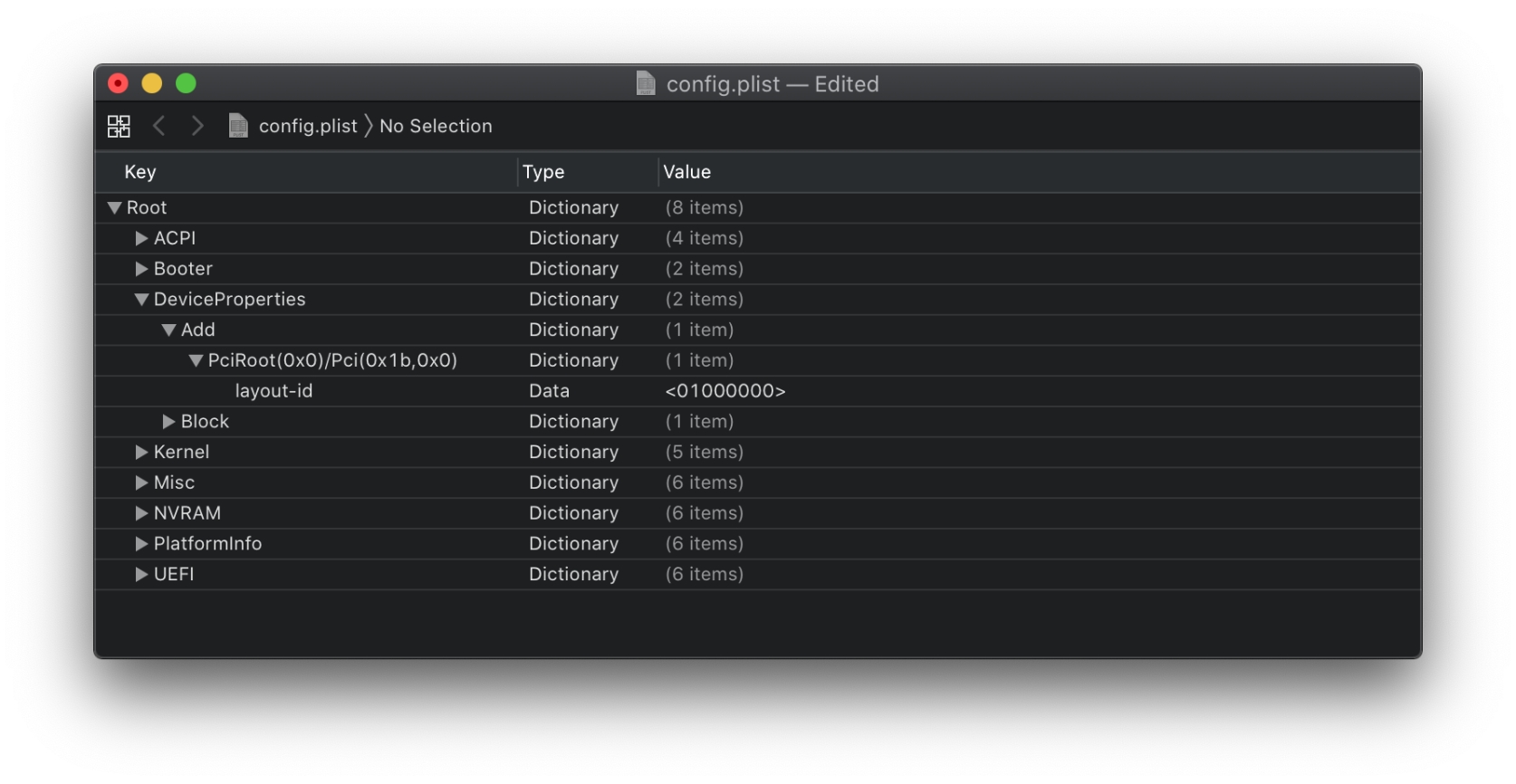
#Add
Sets device properties from a map.
By default, the Sample.plist has this section set for audio which we'll be setting up by setting the layout ID in the boot-args section, so removal of PciRoot(0x0)/Pci(0x1b,0x0) is also recommended from the Add section.
#Delete
Removes device properties from the map, for us we can ignore this
#Kernel

#Add
Here's where we specify which kexts to load, in what specific order to load, and what architectures each kext is meant for. By default we recommend leaving what ProperTree has done, however for 32-bit CPUs please see below:
#Emulate
Needed for spoofing unsupported CPUs like Pentiums and Celerons
Cpuid1Mask: Leave this blank
Cpuid1Data: Leave this blank
#Force
Used for loading kexts off system volume, only relevant for older operating systems where certain kexts are not present in the cache(ie. IONetworkingFamily in 10.6).
For us, we can ignore.
#Block
Blocks certain kexts from loading. Not relevant for us.
#Patch
Patches both the kernel and kexts.
#Quirks
Info
Settings relating to the kernel, for us we'll be enabling the following:
AppleCpuPmCfgLock
YES
Not needed if CFG-Lock is disabled in the BIOS
DisableIoMapper
YES
Not needed if VT-D is disabled in the BIOS
LapicKernelPanic
NO
HP Machines will require this quirk
PanicNoKextDump
YES
PowerTimeoutKernelPanic
YES
XhciPortLimit
YES
Disable if running macOS 11.3+
#Scheme
Settings related to legacy booting(ie. 10.4-10.6), for majority you can skip however for those planning to boot legacy OSes you can see below:
#Misc
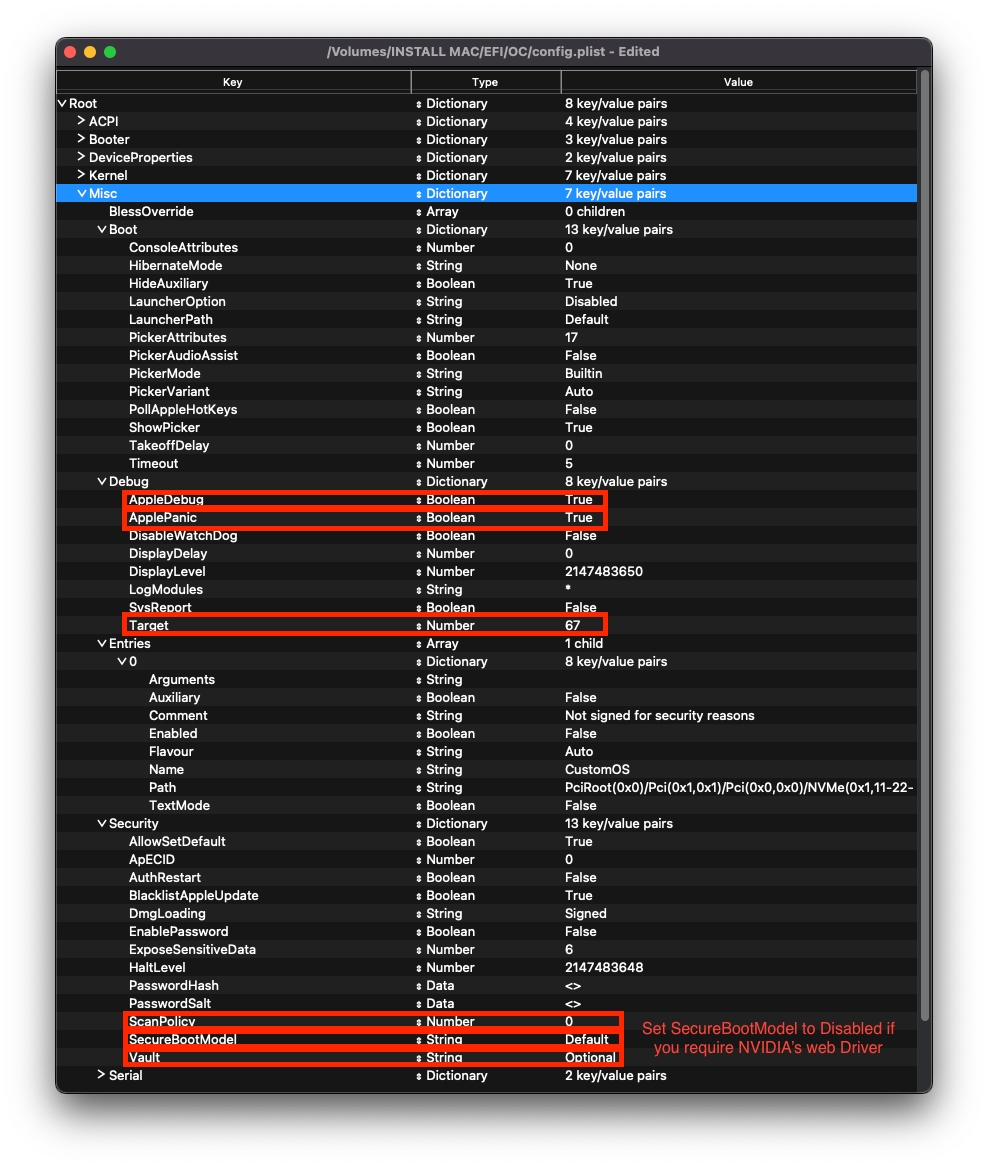
#Boot
Info
HideAuxiliary
YES
Press space to show macOS recovery and other auxiliary entries
#Debug
Info
Helpful for debugging OpenCore boot issues(We'll be changing everything but DisplayDelay):
AppleDebug
YES
ApplePanic
YES
DisableWatchDog
YES
Target
67
#Security
Info
Security is pretty self-explanatory, do not skip. We'll be changing the following:
AllowSetDefault
YES
BlacklistAppleUpdate
YES
ScanPolicy
0
SecureBootModel
Default
Leave this as Default for OpenCore to automatically set the correct value corresponding to your SMBIOS. The next page goes into more detail about this setting.
Vault
Optional
This is a word, it is not optional to omit this setting. You will regret it if you don't set it to Optional, note that it is case-sensitive
#Serial
Used for serial debugging (Leave everything as default).
#Tools
Used for running OC debugging tools like the shell, ProperTree's snapshot function will add these for you.
#Entries
Used for specifying irregular boot paths that can't be found naturally with OpenCore.
Won't be covered here, see 8.6 of Configuration.pdf (opens new window)for more info
#NVRAM
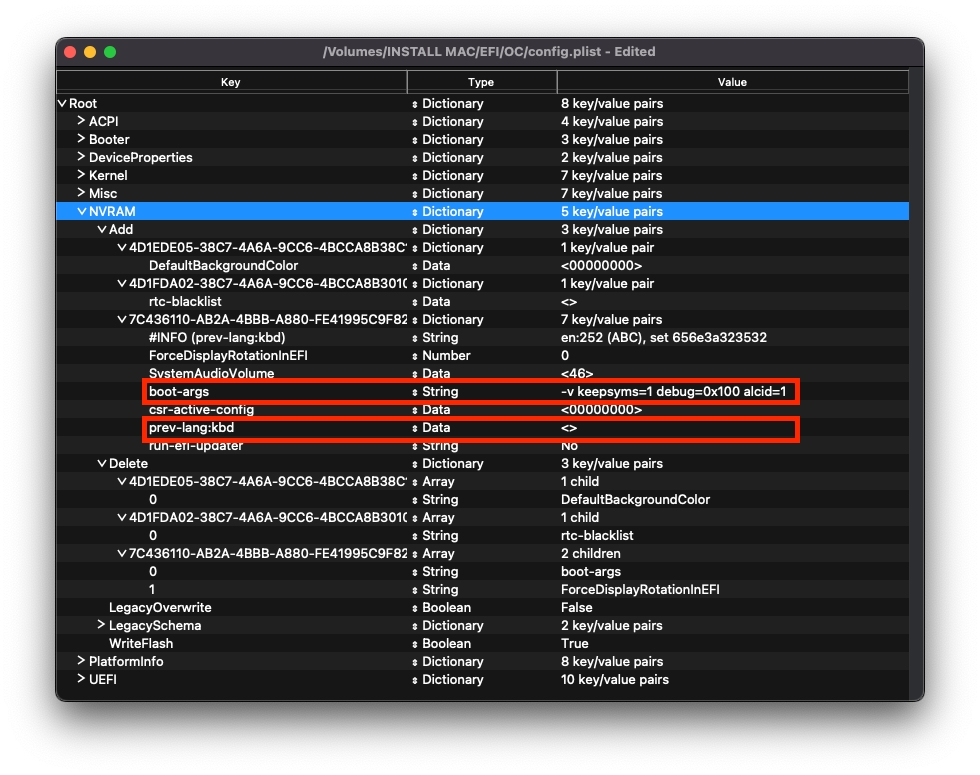
#Add
4D1EDE05-38C7-4A6A-9CC6-4BCCA8B38C14
Used for OpenCore's UI scaling, default will work for us. See in-depth section for more info
4D1FDA02-38C7-4A6A-9CC6-4BCCA8B30102
OpenCore's NVRAM GUID, mainly relevant for RTCMemoryFixup users
7C436110-AB2A-4BBB-A880-FE41995C9F82
System Integrity Protection bitmask
General Purpose boot-args:
-v
This enables verbose mode, which shows all the behind-the-scenes text that scrolls by as you're booting instead of the Apple logo and progress bar. It's invaluable to any Hackintosher, as it gives you an inside look at the boot process, and can help you identify issues, problem kexts, etc.
debug=0x100
This disables macOS's watchdog which helps prevents a reboot on a kernel panic. That way you can hopefully glean some useful info and follow the breadcrumbs to get past the issues.
keepsyms=1
This is a companion setting to debug=0x100 that tells the OS to also print the symbols on a kernel panic. That can give some more helpful insight as to what's causing the panic itself.
alcid=1
Used for setting layout-id for AppleALC, see supported codecs (opens new window)to figure out which layout to use for your specific system. More info on this is covered in the Post-Install Page(opens new window)
GPU-Specific boot-args:
agdpmod=pikera
Used for disabling board ID checks on some Navi GPUs (RX 5000 & 6000 series), without this you'll get a black screen. Don't use if you don't have Navi (ie. Polaris and Vega cards shouldn't use this)
-radcodec
Used for allowing officially unsupported AMD GPUs (spoofed) to use the Hardware Video Encoder
radpg=15
Used for disabling some power-gating modes, helpful for properly initializing AMD Cape Verde based GPUs
unfairgva=1
Used for fixing hardware DRM support on supported AMD GPUs
nvda_drv_vrl=1
Used for enabling NVIDIA's Web Drivers on Maxwell and Pascal cards in macOS Sierra and High Sierra
csr-active-config:
00000000Settings for 'System Integrity Protection' (SIP). It is generally recommended to change this with
csrutilvia the recovery partition.csr-active-config by default is set to
00000000which enables System Integrity Protection. You can choose a number of different values but overall we recommend keeping this enabled for best security practices. More info can be found in our troubleshooting page: Disabling SIP
run-efi-updater:
NoThis is used to prevent Apple's firmware update packages from installing and breaking boot order; this is important as these firmware updates (meant for Macs) will not work.
prev-lang:kbd: <>
Needed for non-latin keyboards in the format of
lang-COUNTRY:keyboard, recommended to keep blank though you can specify it(Default in Sample config is Russian):American:
en-US:0(656e2d55533a30in HEX)Full list can be found in AppleKeyboardLayouts.txt(opens new window)
Hint:
prev-lang:kbdcan be changed into a String so you can inputen-US:0directly instead of converting to HEXHint 2:
prev-lang:kbdcan be set to a blank variable (eg.<>) which will force the Language Picker to appear instead at first boot up.
prev-lang:kbd
String
en-US:0
#Delete
Info
Forcibly rewrites NVRAM variables, do note that Add will not overwrite values already present in NVRAM so values like boot-args should be left alone. For us, we'll be changing the following:
WriteFlash
YES
#PlatformInfo
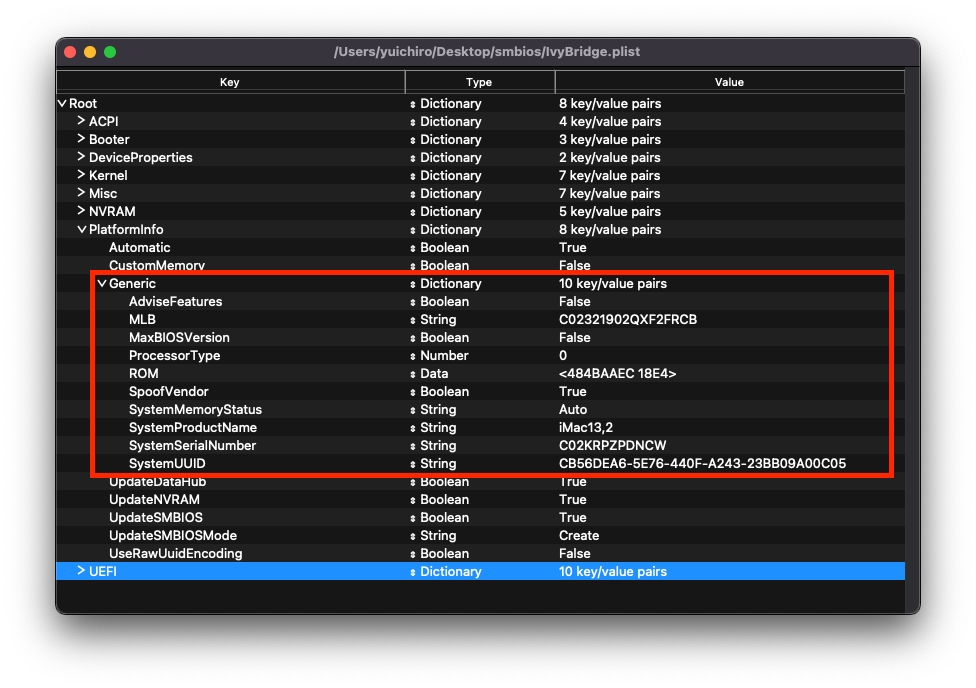
Info
For setting up the SMBIOS info, we'll use CorpNewt's GenSMBIOS (opens new window)application.
For this Clarkdale example, we'll chose the iMac11,2 SMBIOS - this is done intentionally for compatibility's sake. There are 3 main SMBIOS used for Clarkdale:
iMac11,1
Lynnfield SMBIOS
iMac11,2
Clarkdale SMBIOS
MacPro6,1
Mojave and newer SMBIOS
If you plan to later run macOS 10.14, Mojave or newer, MacPro6,1 will be the recommended SMBIOS and the iGPU must be disabled in the BIOS due to no longer being supported
Run GenSMBIOS, pick option 1 for downloading MacSerial and Option 3 for selecting out SMBIOS. This will give us an output similar to the following:
#######################################################
# iMac11,2 SMBIOS Info #
#######################################################
Type: iMac11,2
Serial: C02KCYZLDNCW
Board Serial: C02309301QXF2FRJC
SmUUID: A154B586-874B-4E57-A1FF-9D6E503E4580The Type part gets copied to Generic -> SystemProductName.
The Serial part gets copied to Generic -> SystemSerialNumber.
The Board Serial part gets copied to Generic -> MLB.
The SmUUID part gets copied to Generic -> SystemUUID.
We set Generic -> ROM to either an Apple ROM (dumped from a real Mac), your NIC MAC address, or any random MAC address (could be just 6 random bytes, for this guide we'll use 11223300 0000. After install follow the Fixing iServices (opens new window)page on how to find your real MAC Address)
Reminder that you need an invalid serial! When inputting your serial number in Apple's Check Coverage Page (opens new window), you should get a message such as "Unable to check coverage for this serial number."
Automatic: YES
Generates PlatformInfo based on Generic section instead of DataHub, NVRAM, and SMBIOS sections
#Generic
#UEFI
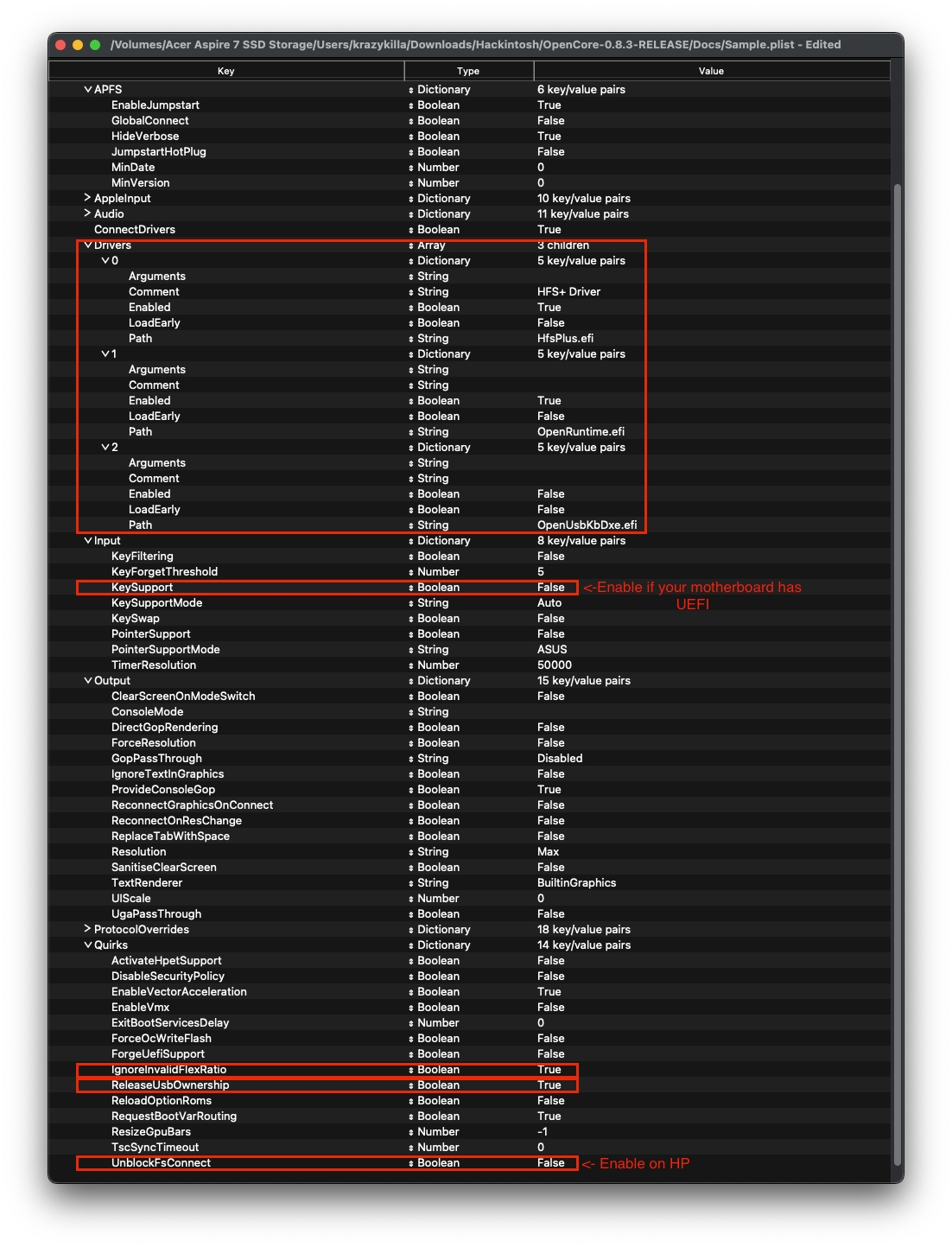
ConnectDrivers: YES
Forces .efi drivers, change to NO will automatically connect added UEFI drivers. This can make booting slightly faster, but not all drivers connect themselves. E.g. certain file system drivers may not load.
#Drivers
Add your .efi drivers here.
Only drivers present here should be:
HfsPlusLegacy.efi
OpenRuntime.efi
OpenUsbKbDxe.efi(If your firmware does not support UEFI)
#APFS
By default, OpenCore only loads APFS drivers from macOS Big Sur and newer. If you are booting macOS Catalina or earlier, you may need to set a new minimum version/date. Not setting this can result in OpenCore not finding your macOS partition!
macOS Sierra and earlier use HFS instead of APFS. You can skip this section if booting older versions of macOS.
APFS Versions
Both MinVersion and MinDate need to be set if changing the minimum version.
High Sierra (10.13.6)
748077008000000
20180621
Mojave (10.14.6)
945275007000000
20190820
Catalina (10.15.4)
1412101001000000
20200306
No restriction
-1
-1
#Audio
Related to AudioDxe settings, for us we'll be ignoring(leave as default). This is unrelated to audio support in macOS.
For further use of AudioDxe and the Audio section, please see the Post Install page: Add GUI and Boot-chime(opens new window)
#Input
Info
Related to boot.efi keyboard passthrough used for FileVault and Hotkey support, leave everything here as default besides:
KeySupport
NO
Enable if your BIOS supports UEFI
#Output
Relating to OpenCore's visual output, leave everything here as default as we have no use for these quirks.
#ProtocolOverrides
Mainly relevant for Virtual machines, legacy macs and FileVault users. See here for more details: Security and FileVault(opens new window)
#Quirks
Info
Relating to quirks with the UEFI environment, for us we'll be changing the following:
IgnoreInvalidFlexRatio
YES
UnblockFsConnect
NO
Needed mainly by HP motherboards
#ReservedMemory
Used for exempting certain memory regions from OSes to use, mainly relevant for Sandy Bridge iGPUs or systems with faulty memory. Use of this quirk is not covered in this guide
Last updated